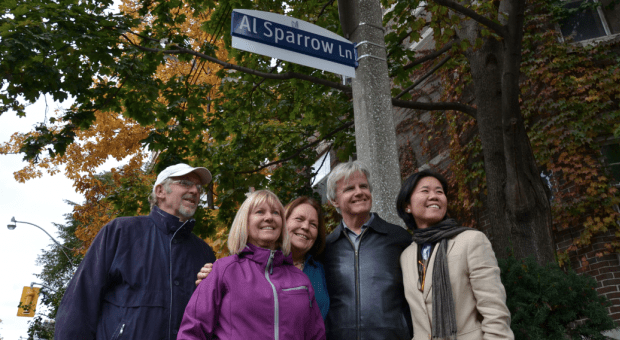In 1981, former Toronto alderman Al Sparrow stepped aside to allow George Hislop, the city’s first openly gay candidate, to launch his historic election campaign.
A tribute to Sparrow, who served between 1974 and 1980 under mayor David Crombie, now adorns a small laneway just east of Church and Isabella streets.
Al Sparrow Lane sits adjacent to Church and Isabella co-op, the residents of which nominated Sparrow unanimously for the honour.
At the unveiling ceremony on Oct 22, Sparrow’s widow, Sue, spoke about her husband’s legacy to Toronto and his passion for human rights. He represented gay and lesbian interests at city hall at a time when it was very controversial to do so. He was instrumental in founding the 519 Church Street Community Centre and helping to carve out what would eventually become the Church-Wellesley gaybourhood.
Sparrow agreed to run for a third term but then stepped aside, setting the stage for Hislop to run for the seat, Sue says. Sparrow campaigned heavily on Hislop’s behalf and Sue worked as Hislop’s campaign manager.
“I ran that campaign with another fellow, and unfortunately we didn’t win,” she says. “It was probably one of the most hateful campaigns I have seen in Toronto, but I am really pleased that it has paved the way for many openly gay councillors and premiers today.”
During his time at city hall, Sparrow was called “the master of the 15-second quote,” she says.
“Al was an insightful, intelligent and principled guy who helped shape the city we know today,” she says. “He was chosen by the people to run in the 1974 municipal election when he just turned 30.”
Greg Greason, board president of the Church and Isabella co-op, says Sparrow ensured that the building stayed in the hands of the residents.
“He saw this project through from the beginning,” he says. “And because of his leadership we have 30 units of affordable housing here in the downtown Church and Wellesley neighbourhood.”
When the time came to suggest a name for the laneway, Greason says the board immediately and unanimously endorsed Al Sparrow.
During his years as a councillor and as a civic activist, Sparrow was ahead of his time, says Councillor Kristyn Wong-Tam. He was a vocal champion of cycling infrastructure, pedestrian spaces, parks and government transparency, and he fought TTC fare hikes.
A tireless advocate for marginalized people, Sparrow tackled racism, sexism and homophobia on Toronto’s police force by promoting community policing and civilian oversight. He even removed height and weight restrictions for Toronto officers so women could qualify for the force.
Sparrow also opposed censorship and lobbied for increased funding for the arts. Later in life he fought hard to curb expansion of the island airport and eventually founded the grassroots group CommunityAIR, which is still fighting expansion today.
“Downtown Toronto owes him a great debt of thanks,” Wong-Tam says. “Even after vacating his seat on council, he remained active in the critical life of this city . . . The work that he accomplished as a councillor and as a citizen will not be diminished in its significance.”
Sparrow died in 2008 at age 63 after a long battle with cancer.
Al Sparrow Lane is the latest in Toronto’s laneway naming project, supported by residents’ associations like the Church and Wellesley Neighbourhood Association.
Another laneway in the Village is honouring Macy DuBois, a founding member of the architectural firm Fairfield and DuBois. Macy DuBois Lane is located off Charles Street, just west of Church Street.
DuBois played a central role in shaping the city’s architecture from the 1960s to the 1980s. He designed numerous buildings, including Oxford University Press, New College at the University of Toronto and the office for Dow Corning Silicones.
“The Church and Wellesley Neighbourhood Association has displayed incredible leadership by ensuring that all the laneways in the area have a proper name,” Wong-Tam says.

 Why you can trust Xtra
Why you can trust Xtra


